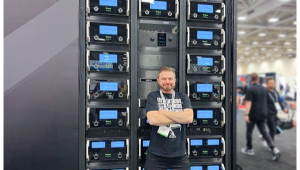Netflix in Tow, LG Rolls Out Ultra HD OLED
I hadn’t much chance to properly view the $8,999 set for more than a few moments in Vegas, but the company took an appropriately dimmed meeting space over in the Hell’s Kitchen neighborhood for this event, and I spent a good while in front of a sample running a 4K trailer for the new Netflix Daredevil series debuting on the service tomorrow. This Marvel-originated series, which was shot in native 4K on the nearby streets with RED Epic Dragon cameras, offers up a lot of dark, challenging imagery, both interior shots and nighttime cityscapes. I admit to being pretty mesmerized by the picture quality, not just with the deliciously crisp image (from only 4 feet away, so it had better be), but also with how the outstanding deep black and shadow rendition made even this show’s muted color palate come to life. And though I really hate to say it, the very fine screen curvature and sparse aesthetics of this TV, what LG calls its “Art Slim” design, looked really sweet. I’m not getting soft on curved screens, but this one was unusually tolerable, if not enticing, and I definitely felt a bit of tech lust.
The “regular” LED UHD line looked about as I’d expect for a demo: flashy and punched up (especially those sets featuring wide color gamut modes, which we don’t recommend people use for Rec.709 content). But the LEDs were still an obvious let-down next to the OLEDs. You’ll find some line details and pricing here. LG also showed off some new speakers and a new soundbar for its Music Flow wireless multiroom audio system, which we hope to review this year now that they’ve built out the line a bit.
The main event, though, was a technical panel discussion put together by LG to discuss the implications of both OLED and 4K. It included Scott Mirer, vice president, device partner ecosystem, at Netflix, and Matt Lloyd, an accomplished cinematographer and the director of photography for Daredevil, who showed off some clips under the watchful eye of a security official who scanned the audience to make sure we weren’t taking video of the as-yet unreleased content. The talk veered into serious geek territory from time to time, and tech expert Pete Putnam of ROAM Consulting eloquently described the import of OLED’s role as the latest in a string of highly desirable and high-performing emissive displays that make their own light, following in the footsteps of defunct CRT and plasma technology. During the Q&A session, LG’s director of new product development for home entertainment products, Tim Alessi, addressed the burning question of OLED “burn-in,” which I’ve seen some evidence of at trade shows when these sets are left fired up all weekend at full brightness reproducing the same repeating loops and logos.
“Umm, we prefer to call it ‘temporary image retention,’” Alessi said wryly, but he hastened to add that “with a little bit of common sense and care, there’s little risk.” That means avoiding leaving stationary images on screen for lengthy periods, as you would with any plasma. He said the OLEDs have an automatic brightness adjustment that kicks in and dims them when they detect stationary screen content that could be dangerous, and they do some kind of automatic pixel shuffling whenever the set is powering down to help mitigate this issue. LG has had OLED in the market now for two years, Alessi said, and “with a few rare exceptions there has not been any real reports of image retention.” The sets are said to hit half-life brightness at around 30,000 hours, or about 15 years of average viewing.
HDR (high dynamic range) capability is not offered in the new LG UHDTVs, so it wasn’t discussed during the panel, but I was able to query Netflix’s Mirer afterward on where the streaming service stands with moving HDR into practice. Netflix publicly committed at CES to bringing HDR to life on new Samsung and Sony models that can reproduce the super-bright highlights that are missing from typical displays, provided they are delivering HDR-encoded content that the TV’s can recognize and reproduce in their full glory.
Mirer noted that progress is being made toward settling an industry standard for HDR production and encoding, though he acknowledged that more than one entity was promoting somewhat different parameters for an HDR signal—a reference to the jockeying currently going on between Dolby, with its Dolby Vision system, and whatever is being crystalized by the Ultra HDTV Alliance, a group of manufacturers, studios, and post houses. But he seemed confident Netflix would deliver HDR programming in calendar 2015. Fortunately, when it does, it won’t be a huge strain on bandwidth: adding both the brighter highlights of HDR and the wider “digital cinema” or P3 color gamut that’s also promised will add only 2 megabits per second of data to the typical Netflix 4K stream, bringing it from 15 mbps to about 17 mbps.
Of course, the coming Ultra HD Blu-ray disc is spec’d to handle more than 100 mbps, plenty enough for HDR. But that will have to wait for an update to the present HDMI 2.0 interface, which currently has no facility for recognizing the flags that will tell it when it sees HDR content or an HDR capable display. Netflix won’t have that issue when HDR signals originate directly from the built-in streaming platforms of this year’s HDR sets.





























































